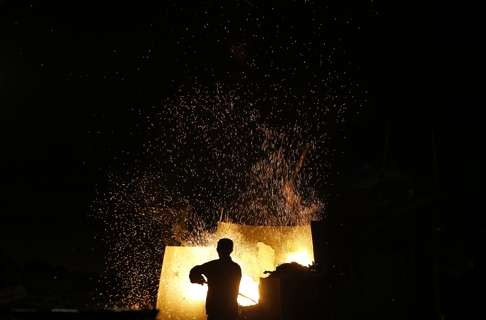Aluminium supply to tighten as prices rebound but ‘structural’ excess capacity remains in China

Global and Chinese demand for lightweight industrial metal aluminium will remain strong and supply outside China will continue to tighten this year, creating conditions for firmer prices from near seven-year lows, according to the chief of the world’s second largest producer Rusal.
Rising exports of Chinese processed aluminium products – which were hit with anti-dumping duties in the United States, Australia and the European Union – are also projected to slow down this year as the premium in overseas prices versus domestic prices narrows, chief executive Vladislav Soloviev of the Moscow and Hong Kong-listed firm told the South China Morning Post.
“Rusal estimates that [global] aluminium consumption will grow by 5.7 per cent to 59.5 million tonnes this year,” he said in exclusive written comments to the Post. “Chinese growth is expected to continue to be strong at 7 per cent year-on-year in 2016 to 31 million tonnes.”
Soloviev expects the transportation sector that covers automobile and aviation equipment to continue to lead demand growth, followed by the construction, electrical, consumer durables and packaging sectors.
On the supply side, the projected increase in net capacity addition in China could be more than offset by plant closures elsewhere, he said.
“We see no new significant capacity additions over the next five years outside China, with [the supply] deficit forecast to [rise] sharply in 2016 and expected to surpass 2.4 million tonnes this year,” Soloviev said.
Rusal believes 1 million tonnes of additional capacity outside China is at risk of being mothballed in this year’s second half if the current depressed prices are sustained, on top of the 1 million tonnes of closures forecast in the 9 months to June 30.
In China, the company projected capacity additions (net of plant closures) to more than double to 1.5 million tonnes this year from 0.7 million tonnes last year, due mainly to a lower level of capacity curtailment, while new plants continue to come on stream.
“Around 50 per cent of closed capacity is highly unprofitable at [an aluminium] price below 12,000 yuan (HK$14,368) per tonne [and] thus has little chance to be restarted,” Soloviev said.
Even if domestic Chinese aluminium prices rise, the restarting of mothballed production lines would be kept in check by rising prices of the raw material bauxite and intermediate product alumina due to tighter supply, he added.
On the back of supply chain restocking and amid signs the economic slowdown has stabilised, aluminium prices have rebounded by more than 10 per cent in the past month to around US$1,635 a tonne, a six-month high, but still not far off their seven-year lows.
China’s aluminium output grew 10.3 per cent last year, down from 12.8 per cent in 2014, and was the fourth consecutive year of slowdown, according to Haitong Securities’ analysts.
“With alumina price rebounding from the trough, the implementation of fees charged by grid operators on grid-connected power plants owned by [smelters], and power plant facilities upgrades to meet more stringent pollution reduction requirements, [mean that] aluminium production costs will rise,” they said in a report. “With supply slightly tight, aluminium price is set to continue its rebound.”
Still, the average plant utilisation rate of China’s aluminium industry stood at only 75 per cent last year, with idled and curtailed capacity amounting to 12.5 per cent the total, according to a China International Captial Corp report.

“This is a vicious cycle: while volumes increase, prices and margins fall,” he said. “This makes it impossible to invest in innovation or create new high-end products ... the best solution would be to keep four to five large players [by consolidating] the industry.”
Shandong province-based China Hongqiao, the world’s third largest aluminium smelter in 2013, unseated Rusal in the No 1 position last year, after it expanded annual capacity by 3.17 million tonnes in the three years to the end of last year.
Its new production lines are among the most energy-efficient and cost-competitive globally.
Hongqiao planned to grow capacity by a further 15.6 per cent this year to 6 million tonnes, which it said would be the last phase of its expansion plan approved by the government.
By contrast, Rusal mothballed 647,000 tonnes of capacity between 2012 and 2014.
Heidi Brock, president of the Aluminum Association that represents US firms, said earlier this month that China’s share of aluminium production jumped from 10 per cent of the global total a decade ago to over 55 per cent last year, while that in the rest of the world fell or remained flat.
She said the US has lost 3,500 jobs as smelters were forced to idle 60 per cent of their capacity, while Chinese capacity grew both due to new capacity additions and insufficient closure of uncompetitive production lines that have been in operation only because of subsidised electricity.